Security Risks to the Caribbean Cruise Industry in 2019
The Cruise Industry and its Investments for Caribbean Itineraries
Cruises are a USD 30 billion+ industry according to the most recent estimates and are expected to continue to rise. The Caribbean cruise market continues to dominate the sector, but its dominance is challenged by the Mediterranean market, as well as more niche markets including northern Europe and Alaska, although some markets are strictly seasonal during the summer months. Additionally, the cruise industry is dominated by only a couple of companies, under which fall their various brands (i.e. Carnival Corporation owns Carnival Cruise, Costa Cruises, Princess Cruises and Holland America among others).
With that, a number of cruise lines and ports have launched multi-million-dollar investments into new, larger and more innovative ships, as well as new terminals at ports to accommodate these new ships and their passengers. The majority of these investments are being made on the expectation that an influx of passengers will take place as more baby boomers retire, in addition to cruise lines seeking more international passengers, particularly from the Asian market. Despite the increases in cruise passengers over the last few years, cruise lines are still aware of the issues that could have an impact on these numbers, particularly the global economy and geopolitics such as the trade relations with the United States and China. A downturn in the global economy would impact the disposable of individuals and families that may have been used for a cruise. Currently, the industry and ports are making record profits, and large investments for the next several years have been made or are in the process of being made to continue to evolve the cruise industry.
Some of the largest investments are being made at the two busiest cruise ports in the world, the Port of Miami and the Port of Canaveral, both in the United States of America. The Port of Canaveral has seen record numbers in regard to total revenue among other indicators. The cruise industry is part of these revenue numbers, and acts as a major driver of the tourism industry in the area. The port is seeing the construction of a USD 150 million Cruise Terminal 3 in addition to a 1,700-space parking garage to accommodate the arrival of Carnival Cruise Line’s largest ship, which is expected to debut in the autumn of 2020. The expansion of Disney Cruise Line’s ship roster has also led the port to have plans to conduct a USD 48 million upgrade to Cruise Terminals 8 and 10, expected to be complete in 2021. At the Port of Miami, Norwegian Cruise Lines is working on building a terminal to be completed for February 2020, while Royal Caribbean Cruise Lines is launching Terminal A after an investment of USD 250 million. Elsewhere on the continental United States, Royal Caribbean has confirmed that it will make a close to USD 100 million investment to build a third terminal at the Port of Galveston in order to accommodate Oasis-class ships, for which they would have the exclusive port rights to. The terminal would be set to open in fall of 2021.
Elsewhere in the Caribbean, the Dominican Republic’s Port Authorities have states that a USD 125 million investment would be made to build a new cruise port in Puerto Plata, which would be able to accommodate 680,000 passengers per year starting in 2020. In the autumn of 2019, MSC Cruises is expected to inaugurate its new port on Ocean Cay, an island bought in the Bahamas to add as a destination, and which will include a spa, wellness sanctuary, six beaches, an inland lagoon and a party/wedding venue. With an expanding cruise ship roster, Disney Cruise Line has received the approval of the Bahamian government to buy over 700 acres of privately-held land at Lighthouse Point on Eleuthera to build a port. More negotiations are expected to determine the terms of the land development. Finally, Carnival Cruise Line has signed an agreement to build private port on Grand Bahama with a reported cost of USD 200 million, although this project has yet to have a timeline. Besides the large investments in port infrastructure, several cruise lines have new ships being built. The high cost of both requires that security measures are able to handle emerging threats the industry and the companies involved may face. In regard to security, Port Canaveral is working with government representatives to add language in a bill to ensure adequate U.S. Customs and Border Protection officers at ports handling cruises to ensure safety and a quick process in regard to immigration proceedings.
Threats to the Cruise Industry in the Caribbean
Cruise operators are challenged to develop competitive cruise packages for potential clients through developing new itineraries, high-quality onboard amenities, as well as shore-based excursions giving access to various cultural sites and activities in the countries where the ships dock. While the ship itself faces security threats, the activities on board and on shore also provide ample opportunities for targets and security flaws to be exploited by anyone with the means and motivation. This is why cruise companies monitor potential security threats in the countries in which they will make a port call, in order to provide passengers the best security advice and ensure the cruise and its activities are not endangered.
In order for on-shore activities to be successful, the cruise lines have to handle the logistics to ensure a quick and easy way for passengers to disembark and get to the activities in which they will take part in. For certain ports, ferries are used to transport passengers, as is the case for ships arriving in Cozumel, Mexico and transferring passengers to the mainland in Playa del Carmen, Mexico. In February 2018, a tourist ferry exploded due to improvised explosive device leaving 25 individuals injured. Several days later in March 2018, another explosive device was found attached to the hull of another tourist ferry.
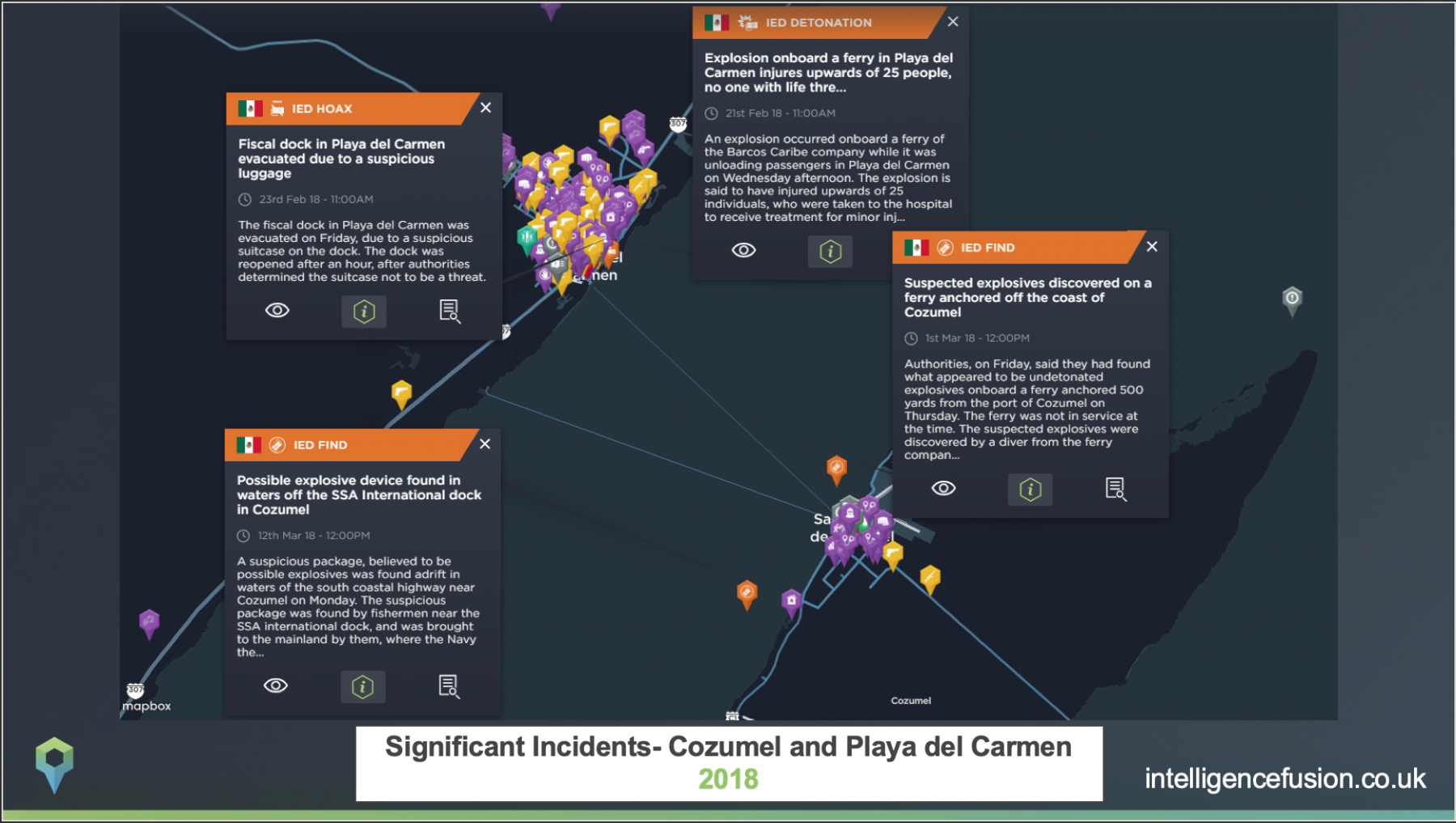
The incidents prompted the United States Embassy to issue a security alert for the area and led to several cruise lines including Carnival Cruise Line, Royal Caribbean International, and Norwegian Cruise Line among others to cancel shore excursions that made use of the ferries. Other excursions not using ferries were unaffected. The explosion in the ferry was reportedly claimed by a criminal group aligned with the Los Zetas drug cartel. The incident is a reminder that the tourism industry, including cruise ships and their passengers, may be directly or indirectly the victims of the criminal dynamics of the countries in which they stop in.
Common criminal activity in ports of call should also be watched and considered by cruise lines and their passengers. Passengers going on shore, but not as part of an activity organized by the cruise line, could face crimes such as theft, extortion, and sexual offences among others. A recent letter given to passengers on board the Royal Caribbean’s Anthem of the Seas cruise ship, which was signed by the Captain, warned of the increase in crime in certain parts of Nassau, Bahamas and to be vigilant when leaving the ship shortly before the ship was to dock there. The letter was denounced by the Bahamas’ Minister of Tourism who said that passengers were safe and that it was unfair to have the destination depicted by an incident that may affect a passenger on a rare basis. After discussions between Royal Caribbean and the tourism minister, the company agreed to halt its security recommendation it had made to passengers.
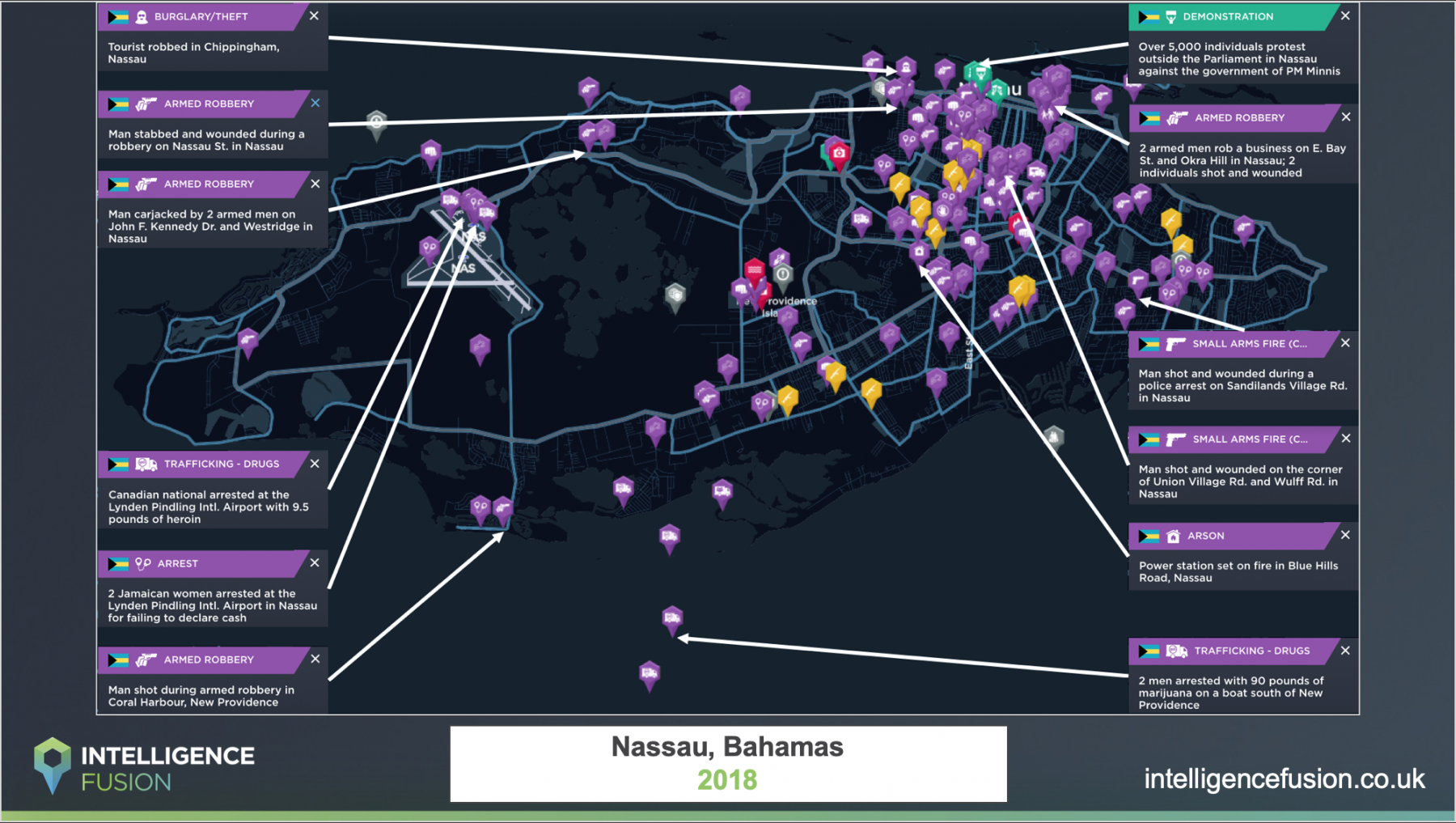
Criminal activity in countries where cruises make ports of calls is quite similar across the Caribbean with certain exceptions. Threats and security incidents recorded by Intelligence Fusion in the region often revolve around armed robberies, thefts, sexual assaults, murders and civil unrests. Certain factors like social and economic inequality, drug trafficking, gang activity and illegal migration can also exacerbate tensions in certain areas of the region. While smaller countries in the region don’t have the same incident counts as countries like Jamaica or the Dominican Republic, they do encounter similar threats and normal security precautions should be taken by cruise passengers. Cruise ship passengers most at risk of facing threats at ports of call are those who explore the destination alone and not in an activity organised by the cruise company.
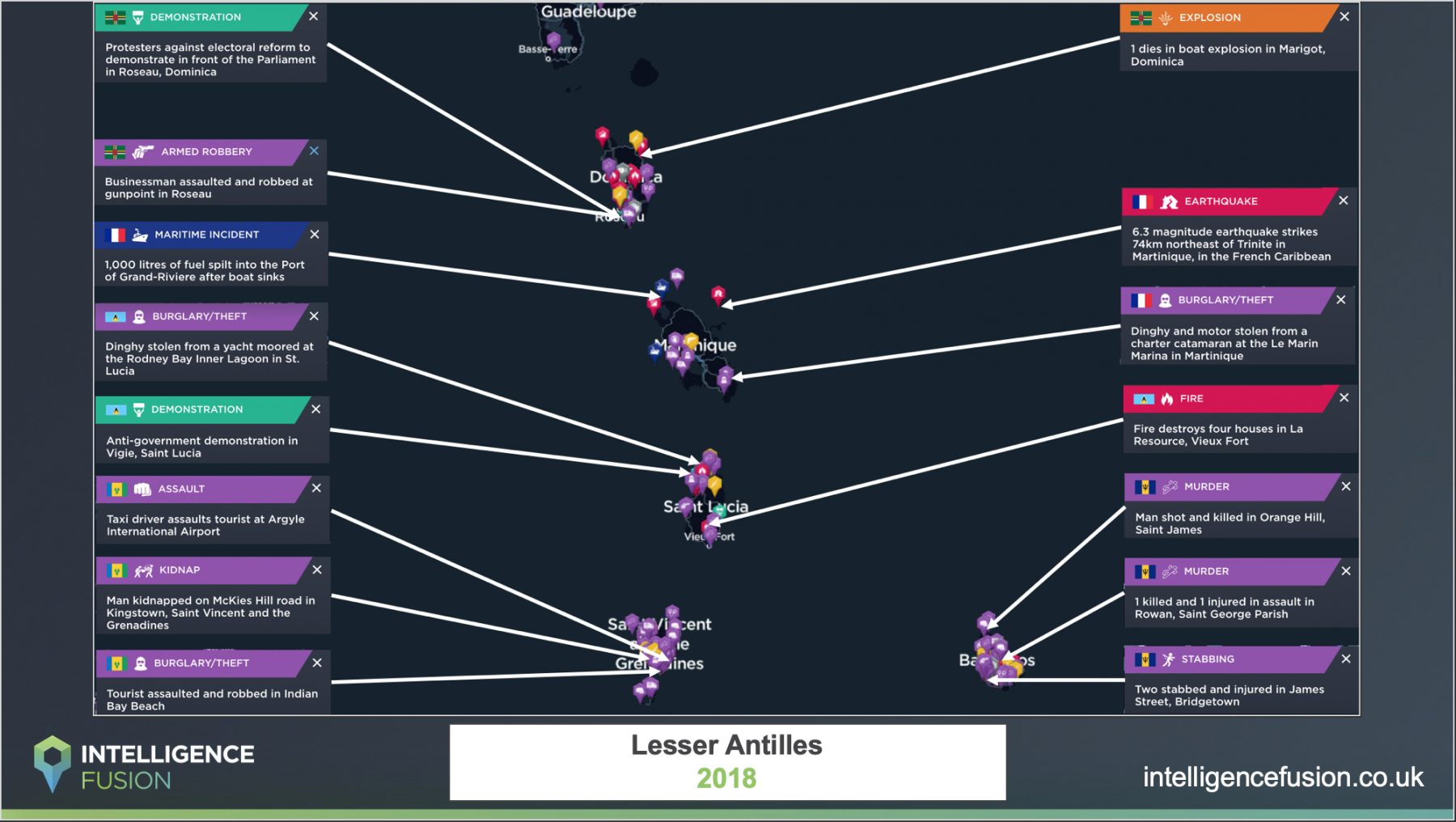
On board cruise ships, passengers face a variety of security and safety issues. Fights between passengers have been reported, often due to alcohol consumption, as well as sexual assaults, with a recent assault having reported to have taken place on board the Carnival Conquest ship in Aruba on 27th December 2018. The U.S. Department of Transportation’s statistics regarding incidents on board cruise ships reflect that sexual assaults and thefts are the most common incidents reported. Other security incidents may take place but not be reported. Other than crime, passengers on board ships may also face outbreaks of diseases, this in part due to thousands of individuals being located in a confined space allowing for the spread of disease to be more efficient. Gastrointestinal illnesses are most common, and 10 outbreaks were recorded on board cruise ships by the Centres for Disease Control and Prevention in 2018, which was down from 11 in 2017 and 13 in 2016. Finally, the potential of falling overboard is to be taken seriously by passengers, as in 2018, several crewmembers and passengers were reported having gone overboard in the Caribbean and Gulf of Mexico, with the causes not known in many of the cases.
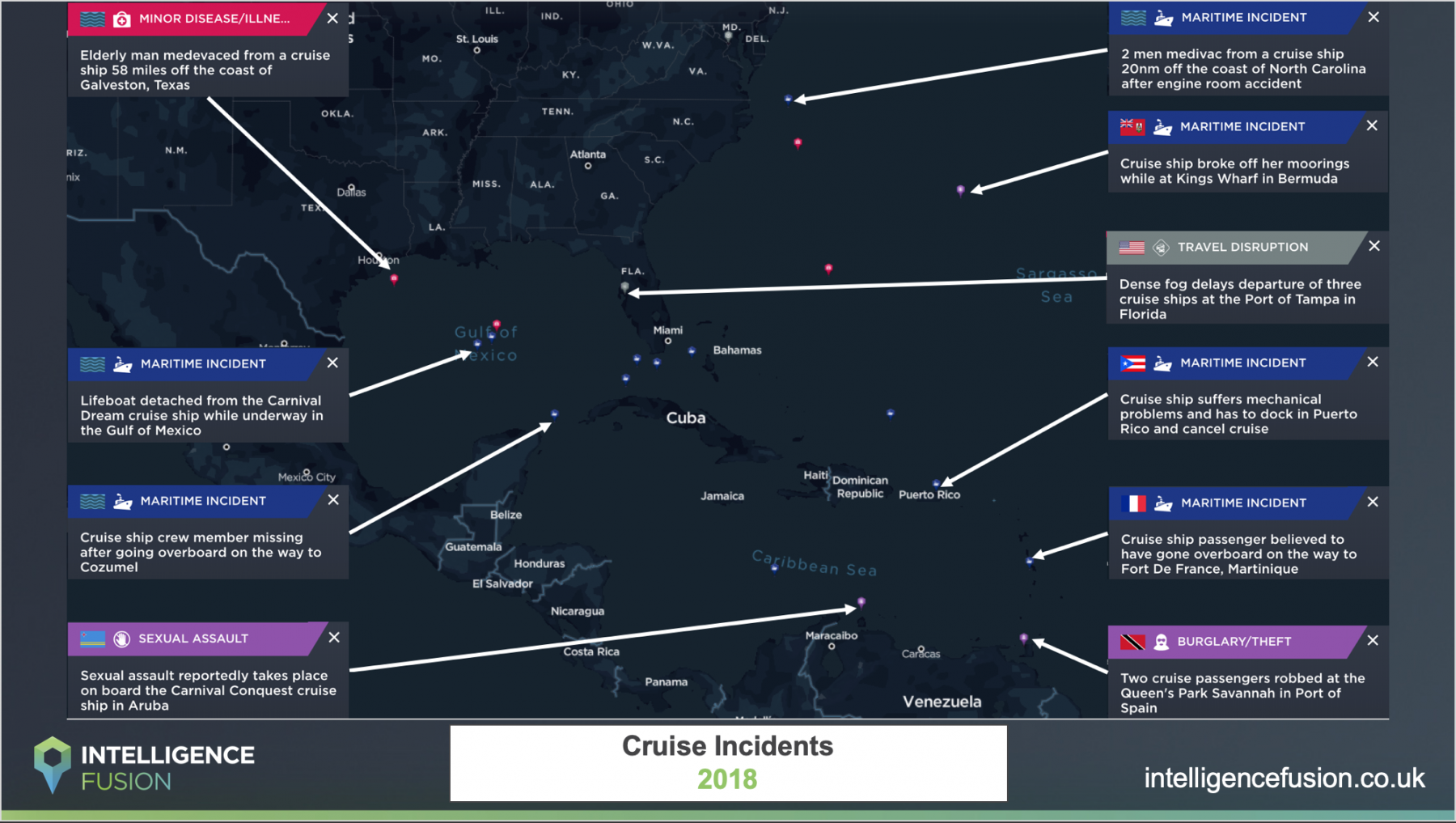
Cruise lines may also face travel disruptions due to inclement weather. For the safety of passengers and crewmembers, cruise lines may divert ships from the path of inclement weather or keep the ships in port. This was seen in September 2018 during Hurricane Florence, in which several Royal Caribbean and Carnival ships were rerouted to the Bahamas to stay out of the path of the storm which struck the coast of the south-eastern United States. A month later, Norwegian Cruise Line and Carnival Cruise Line changed the itineraries of several ships due to Tropical Storm Michael, while Royal Caribbean International delayed the departures of ships from Tampa, Florida and Baltimore, Maryland.
An emerging threat to cruise ships are cyber-attacks. New technologies are being used in order to make cruises more engaging and personalized for passengers, including dinner reservations and location tracking on board the ship. This use of technology opens passengers to have their information exploited through various means. Passenger’s bank details could be exploited if the applications used by cruise ships in which passengers enter their bank details are hacked. E-mail phishing could allow hackers to gain access to the internal systems of the ship through targeting passengers and crew members with the e-mails. There have been reports of researchers being able to take control of a ship by spoofing its GPS and gaining the ability to manipulate operation controls, including ship propulsion. This research shows the potential for a cruise ship to be virtually hijacked and its controls released only after a payment is made to the hijackers.
Finally, one of the largest threats cruise ships face is terrorism. In 1985, the Achille Laure cruise ship was hijacked by four members of the Palestinian Liberation Front off the coast of Egypt. The suspects forced the ship to Tartus, Syria and demanded the release of Palestinians from Israeli prisons in order for them to release the ship. The suspects killed one passenger, and after two days of negotiations they abandoned the ship but were intercepted during their transit to Tunisia. This incident shows that cruise ships are not infallible to the threat of being hijacked, and the Mediterranean, where the incident took place, remains the most likely location if an attack were to take place due to instability in Libya and threats the Islamic State has made. More recently, in March of 2015, an attack by terrorists at the Bardo National Museum in Tunis killed two dozen individuals and wounded over 40, mostly tourists. A number of those killed and wounded were from the MSC Splendida cruise ship which had docked at the port the morning of the attack. The Islamic State claimed the attack, while the government of Tunisia blamed a local group affiliated with al-Qaeda in the Islamic Maghreb. The attack shows the more recent threat of terrorism against cruise lines, particularly in the Mediterranean.
While the Caribbean routes do not face the same level of threat due to its distance from Islamic State areas of control, the threat remains with the potential of lone wolf attacks. An attack on a cruise ship, whether on the ship itself or the passengers would be devastating due to the number of passengers and crew onboard, and the confined spaces. In December 2018, U.S. and Greek Special Forces, along with Greek law enforcement officers, took part in the Jackal Stone 18 exercises, of which one included a scenario in which Islamic State terrorists had stormed a cruise ship full of tourists in the eastern Mediterranean. The ship was then stormed by special forces and law enforcement officers to liberate it of the terrorists. This scenario, one that has been practiced before, indicates that the military and local law enforcement agencies are aware and prepared for such a threat.
In order to combat such threats, cruise lines take similar procedures as airports in that all luggage, carry-ons, provisions, and individuals are screened with x-rays, metal detectors, human searches and sniffer dogs among others. However, with cruises stopping several times along their itineraries, this increases the number of times passengers get off and come back on the ships, increasing the likelihood that a threat is missed.
The cruise industry will likely continue on its trajectory of growth and investments in 2019, and with that will come bigger and more innovative ships, as well as an increase in ships operating and cruise itineraries offered in the Caribbean. This increase in the number of passengers create opportunities for security threats to arise on board and on shore as cruise passengers interact with each other and with local residents of ports of call. An understanding of the security dynamic and threats present at each location along a cruise itinerary allows cruise lines to be proactive in protecting their passengers, ships and port infrastructure. Intelligence Fusion has and will continue to monitor the region to alert of any new emerging threats that could have any impact on the industry, but 2019 does not look like it will challenge the status quo of the current threats present.
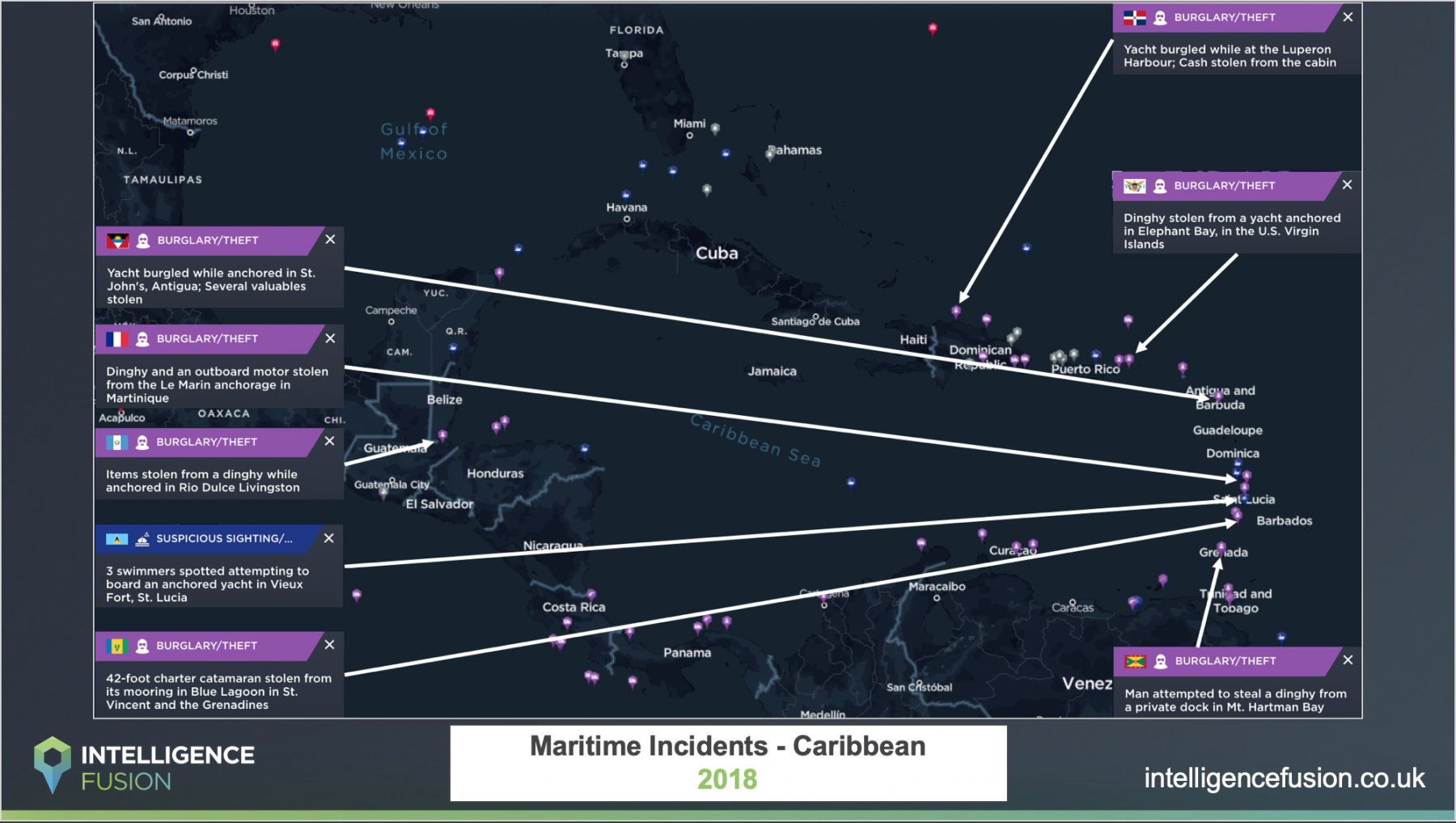
Further areas for Intelligence Fusion to look at:
- Maritime threats in the Caribbean for private yachts
- Threats to tourists in the Caribbean
- Drug smuggling and migration and their impact on crime in the Caribbean
As the cruise industry grows, so does the need for enhanced threat intelligence within the maritime and ports industry. If you’d like some more in-depth advice surrounding the anticipated threats to your organisation in 2019 or to take a deeper look at the kind of intelligence we provide our maritime clients, book your free demo with a member of the Intelligence Fusion team today.


